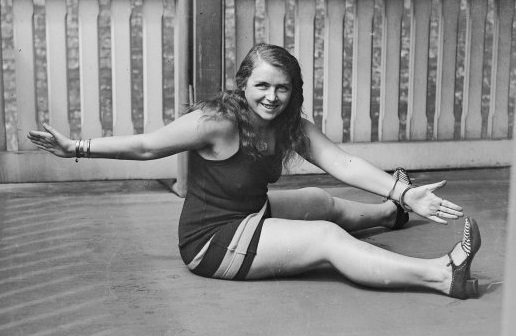Watch this space for the latest from GWD HQ, and keep your FOMO to a BM (that means Bare Minimum).
How to Win a Watch for Swimming Halfway across a Channel

Earlier this year, a blue historical marker was placed outside a house in Brighton, England, denoting it as the birthplace of an early 20th century iron-woman, who inadvertently became one of the world’s first athletes-turned-influencers. Mercedes Gleitze was born in the house that was Blue Plaqued in January, two-plus decades before she became the first Englishwoman to swim the English Channel.
“Celebrity icon of the 1920s, the name Mercedes Gleitze has faded from public consciousness, but it is hoped that the blue plaque, along with the upcoming feature-length biopic depicting the events surrounding her 1927 swim, will rejuvenate her status as a female sporting trailblazer,” Relash Productions, who released that flick about Gleitze, told The Argus at the time.
And although Gleitze may not be a household name — especially on our side of the Atlantic — Rolex founder Hans Wilsdorf definitely never forgot her. Gleitze, who was well-known for not only touching the water of the Thames but swimming in it for upwards of 10 hours a day, decided that she was ready to take on another endurance challenge.
Just before 3 a.m. on October 7, 1927, she slipped into the frigid water in Gris Nez, France and didn’t get out until she’d hit the Kent coast in southeast England. After 15 hours and 15 minutes of swimming, she reportedly had enough energy to say “Thank God, I am conscious!” before promptly losing consciousness in her trainer’s arms.
Gleitze was immediately celebrated for her achievement, and here’s where things took a turn for the bonkers: another British woman named Dorothy Logan said that she’d not only swum the English Channel, but she’d done it two hours faster than Gleitze. The woman’s claims were met with skepticism, and she quickly admitted that she was full of shit — BUT that meant that the eternally jaded English public started to question Gleitze too.
Less than two weeks later, Gleitze basically said “FINE, I GUESS I’LL JUST DO IT AGAIN.” And here’s where Hans Wildorf came in. Rolex had recently released its Oyster watch, which was so named because it “was clamped shut like an oyster shell and could survive under water.” Wildorf gave one to Gleitze, and she wore it on a chain around her neck while she attempted her second Channel crossing.
The water was significantly colder on her second go, and after 10 hours, she decided to call it a day. But because she stuck it out so long, everyone seemed to decide that maybe she’d completed that first swim after all. “”She had swum with remarkable endurance under very difficult conditions,” the London Times wrote. “The temperature of the water varied from 53 to 58 degrees, as compared to 60 degrees on October 7, when she made her successful swim.”
After she regained feeling in her fingers again, Gleitze wrote a letter to Wildorf. “You will like to hear that the Rolex Oyster watch I carried on my Channel swim proved itself a reliable and accurate timekeeping companion even though it was subjected to complete immersion for hours in sea water at a temp of not more than 58 and often as low as 51,” she wrote. “This is to say nothing about the sustained buffeting it must have received […] The newspaper man was astonished and I, of course, am delighted with it.”
That was good enough for Rolex. A month later, Wilsdorf bought an ad that covered the entire front page of the Daily Mail, proclaiming the Oyster as “The Greatest Triumph in Watchmaking.” They also included a photo of Gleitze, who Rolex still describes as “the first Rolex Testimonee” who “demonstrated the new watch’s qualities in action.”
Suck it, Dorothy Logan.
—–
We asked about one of Gleitze’s other swimming accomplishments in the Random Knowledge round of this week’s Twitch quiz. Towel yourself off and check it out right here:
Featured image courtesy of: Public Domain